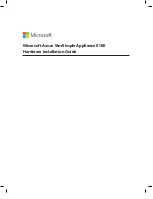
Servicing the CPU
2-15
There are three methods for recovering console and diagnostic code. The
first is to use the
update -f
command; the second is to use the Loadable
Firmware Update (LFU) Utility; and the third is to downline load the con-
sole/diagnostic firmware into the damaged system and copy it into the
FEPROMs. The use of the
update -f
command can only be done in a mul-
tiprocessing system and is documented in Sections 2.3 and 2.4. LFU can
be used when the console is completely functioning and is described in
Chapter 3. The third method, the least desirable, is described here.
Other pertinent information follows:
•
The console terminal must be set at 9600 baud for the AXP-/VAX-
7000/10000-FRRC> prompt to appear.
•
On site or remote access to the system is required.
•
The procedure may take 20 to 30 minutes to complete if there are no
line problems.
What you need is:
•
An independent source system that can logically connect to the dam-
aged system through the console line. The system can be on site or re-
mote. You do not need a DMB32 as shown in Figure 2-1, but you need
some hardware mechanism to connect to the target’s console port.
•
The source system must have access to an RRD42 or an InfoServer.
•
The software program Kermit must reside on the source system.
•
The AXP/VAX 10000 Console CD-ROM, with the console/diagnostic
code on it. The file name for the console/diagnostic code is
AXP7000_10000_CONSOLE_IMAGE.GROM for the DEC 10000 sys-
tem and VAX7000_10000_CONSOLE_IMAGE.GROM for the VAX
10000 system.
The serial line receive program in the serial ROM of the CPU is called
FRRC (FEPROM recovery code). Its function is to receive and store data
sent down the console line.
Summary of Contents for DEC 10000
Page 5: ...v 2 Related Documents xi 1 1 Field Replaceable Units 1 6 2 1 EEPROM Environment Variables 2 2 ...
Page 6: ......
Page 26: ......
Page 46: ......
















































